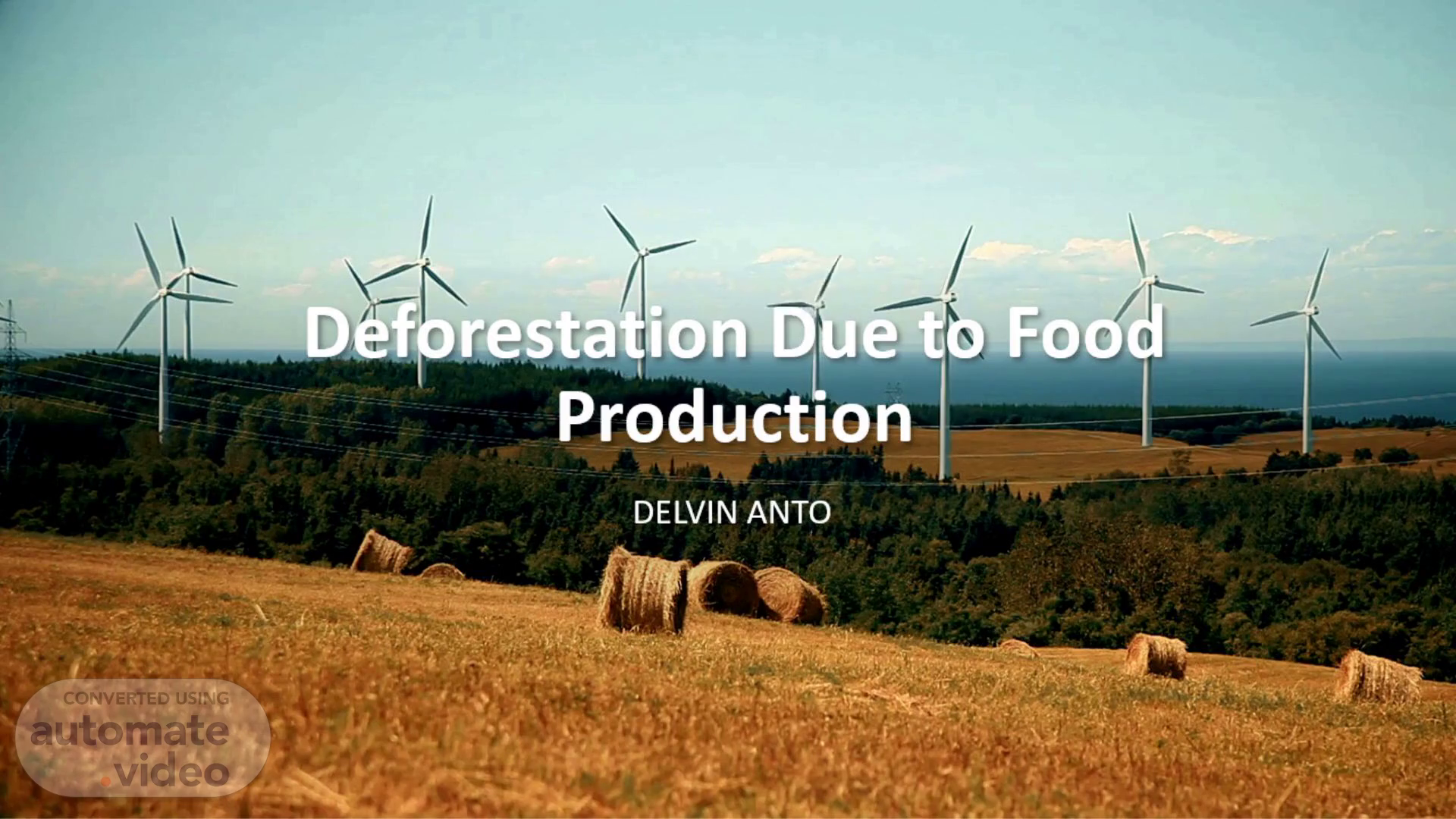
Deforestation Due to Food Production
Scene 1 (0s)
[Audio] Deforestation Due to Food Production. Deforestation Due to Food Production.
Scene 2 (7s)
[Audio] Introduction Deforestation due to food production is a critical issue impacting the environment, society, and economy worldwide. It involves the clearing of forests to make way for agricultural activities such as cattle ranching, soybean farming, and palm oil plantations. This presentation will delve into the current status of deforestation for food production, its impacts on various stakeholders, the importance of addressing this issue, its historical context, and potential solutions..
Scene 3 (38s)
[Audio] Current Status Deforestation for food production remains a significant challenge globally. According to the Food and Agriculture Organization (FAO), agriculture is the leading cause of deforestation, responsible for about 80% of deforestation worldwide. Countries in the Amazon basin, Southeast Asia, and Africa are particularly affected due to the expansion of agricultural land..
Scene 4 (1m 2s)
[Audio] Importance of the Topic •Environmental Sustainability: Forests play a vital role in regulating the climate, maintaining biodiversity, and providing ecosystem services. •Social Justice: Indigenous communities and marginalized populations often bear the brunt of deforestation, leading to social injustices. Economic Stability: Sustainable land use practices can contribute to economic stability in the long run by preserving natural resources and enhancing agricultural productivity.
Scene 5 (1m 37s)
[Audio] Assessment using the 3 Spheres of Sustainability •Environmental Impact: Deforestation leads to habitat loss, biodiversity decline, soil erosion, and increased greenhouse gas emissions, contributing to climate change. •Social Impact: Indigenous communities and forest-dependent populations suffer from land dispossession, loss of cultural heritage, and conflicts over natural resources. •Economic Impact: While deforestation may bring short-term economic gains for agribusinesses, it often leads to long-term economic losses due to environmental degradation, reduced agricultural productivity, and impacts on tourism and ecosystem services..
Scene 6 (2m 20s)
[Audio] History of the Topic •Deforestation for food production has deep historical roots, dating back to colonial expansion and the rise of industrial agriculture. The demand for commodities such as timber, beef, soybeans, and palm oil has driven extensive forest clearing, especially in tropical regions. Policies promoting agricultural expansion and weak enforcement of environmental regulations have exacerbated deforestation trends..
Scene 7 (2m 49s)
[Audio] Spectrum of Solutions Short-term Solutions Strengthening law enforcement to combat illegal logging and land clearing. Implementing sustainable land management practices such as agroforestry and reforestation. Supporting alternative livelihoods for forest-dependent communities.
Scene 8 (3m 7s)
[Audio] Capacity-building Solutions: Providing training and education on sustainable agriculture practices.Investing in research and development of agroecological methods. Empowering local communities to participate in land-use decision-making processes. System Change Solutions: Reforming agricultural subsidies to incentivize sustainable land use practices. Implementing land tenure reforms to secure land rights for indigenous communities. Promoting international cooperation and policies to address the drivers of deforestation, such as commodity supply chains..
Scene 9 (3m 47s)
[Audio] Real-life Example The expansion of palm oil plantations in Southeast Asia serves as a real-life example of deforestation for food production. Countries like Indonesia and Malaysia have experienced significant deforestation to meet the global demand for palm oil, leading to habitat loss for endangered species like orangutans, social conflicts over land rights, and environmental degradation. Efforts to address this issue include certification schemes like the Roundtable on Sustainable Palm Oil (RSPO) and initiatives to promote sustainable palm oil production..
Scene 10 (4m 24s)
[Audio] Conclusion Deforestation due to food production poses serious environmental, social, and economic challenges. Addressing this issue requires a multi-faceted approach that balances environmental conservation, social equity, and economic development. By implementing short-term, capacity-building, and system change solutions, we can work towards a more sustainable and equitable food system that preserves our forests for future generations..
Scene 11 (4m 52s)
REFERENCE. Gibbs, H. K., Ruesch, A. S., Achard, F., Clayton, M. K., Holmgren, P., Ramankutty, N., & Foley, J. A. (2010). Tropical forests were the primary sources of new agricultural land in the 1980s and 1990s. Proceedings of the National Academy of Sciences, 107(38), 16732-16737. DeFries, R. S., Rudel, T., Uriarte, M., & Hansen, M. (2010). Deforestation driven by urban population growth and agricultural trade in the twenty-first century. Nature Geoscience, 3(3), 178-181. Angelsen, A., & Kaimowitz, D. (Eds.). (2001). Agricultural technologies and tropical deforestation. CABI Publishing.Rudel, T. K., Defries, R., Asner, G. P., & Laurance, W. F. (2009). Changing drivers of deforestation and new opportunities for conservation. Conservation Biology, 23(6), 1396-1405. Laurance, W. F., Sayer, J., & Cassman, K. G. (2014). Agricultural expansion and its impacts on tropical nature. Trends in Ecology & Evolution, 29(2), 107-116.Meyfroidt, P., & Lambin, E. F. (2011)..
Scene 12 (5m 46s)
REFRENCE. Global forest transition: prospects for an end to deforestation. Annual Review of Environment and Resources, 36, 343-371.Lambin, E. F., & Meyfroidt, P. (2011). Global land use change, economic globalization, and the looming land scarcity. Proceedings of the National Academy of Sciences, 108(9), 3465-3472.Tilman, D., Balzer, C., Hill, J., & Befort, B. L. (2011). Global food demand and the sustainable intensification of agriculture. Proceedings of the National Academy of Sciences, 108(50), 20260-20264.FAO. (2016). The State of Food and Agriculture 2016. Food and Agriculture Organization of the United Nations.IPCC. (2019). Climate Change and Land: an IPCC special report on climate change, desertification, land degradation, sustainable land management, food security, and greenhouse gas fluxes in terrestrial ecosystems. IPCC..